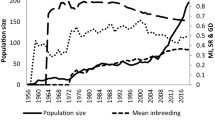Abstract
A population viability analysis (PVA) was conducted for a Japanese black bear population in Shimokita Peninsula, northern Japan, using an individual-based simulation model. Demographic stochasticity was incorporated in the model as well as the environmental stochasticity from the fluctuation of annual mast production. The extinction risk of the population was estimated with an emphasis on the effect of carrying capacity reduction and hunting pressure. The results suggest that the population has a high risk of extinction. Even if there is no further reduction of the carrying capacity and no hunting at all, the present size of the population cannot pass the test of the minimum viable population size (MVP) concept. Considering possible carrying capacity reduction in the future and actual hunting pressure, the population will fail to survive for 100 years at a very high probability. Because of deterioration of habitat and loss of the corridor between habitat areas, the population has become very sensitive to demographic impacts, including hunting pressure.
Similar content being viewed by others
Author information
Authors and Affiliations
Additional information
Received: March 31, 1999 / Accepted: February 10, 2000
Rights and permissions
About this article
Cite this article
Horino, S., Miura, S. Population viability analysis of a Japanese black bear population. Popul Ecol 42, 37–44 (2000). https://doi.org/10.1007/s101440050007
Issue Date:
DOI: https://doi.org/10.1007/s101440050007




